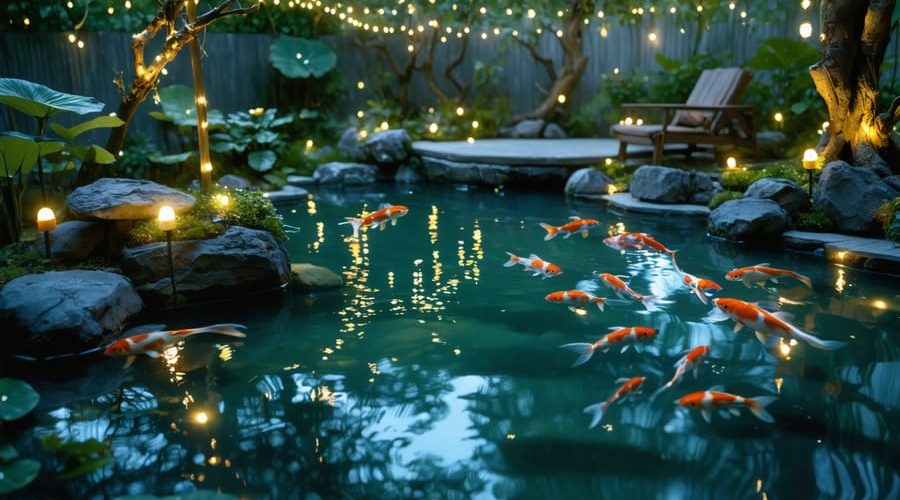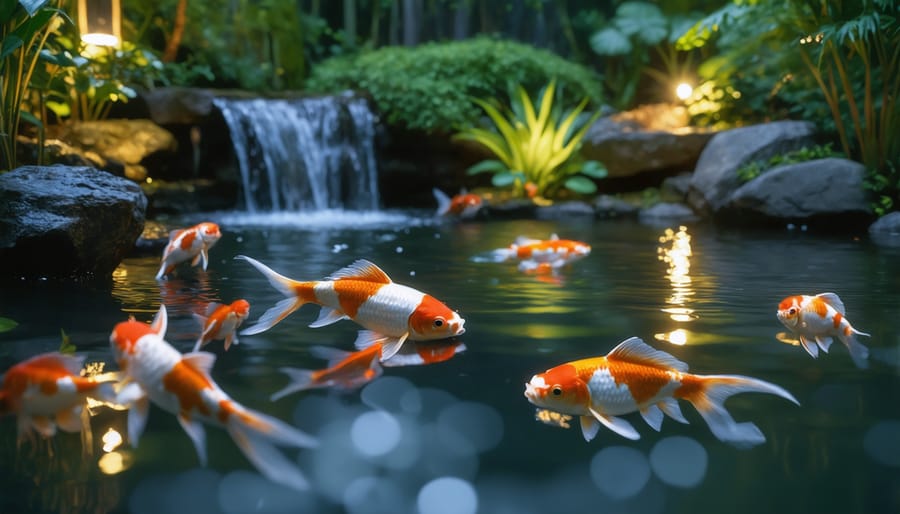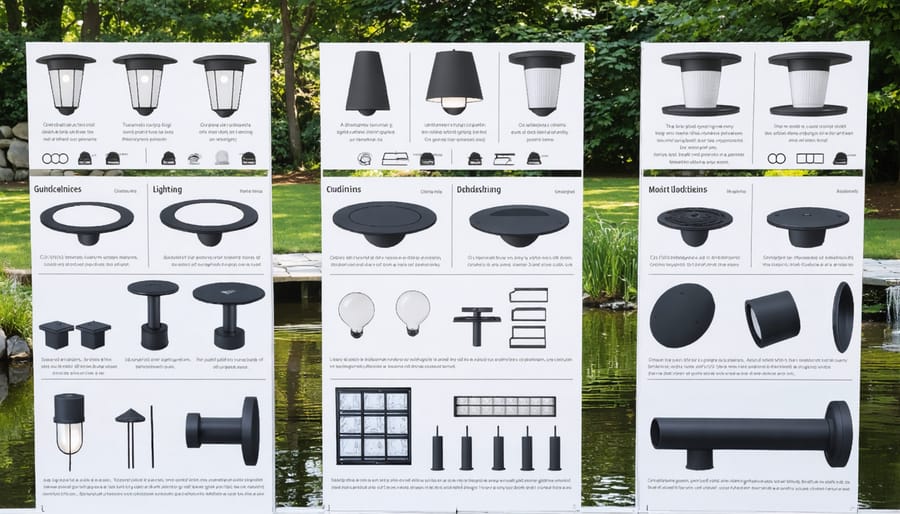
Transform Your Pond into a Magical Night Garden with These Lighting Secrets
Transform your outdoor space into a mesmerizing nighttime retreat by layering multiple light sources at varying heights. Position uplights at the base of trees and architectural features, install pathway markers at ground level, and suspend string lights overhead to create depth and dimension. Integrate dynamic lighting effects around water features using color-changing LED fixtures that ripple and dance with the water’s movement. Focus on highlighting key landscape elements while maintaining dark spaces between lit areas to create contrast and visual interest. Select warm white lights (2700-3000K) for main lighting and reserve colored options for accent features. Combine practical security lighting with decorative elements by positioning motion-activated flood lights discreetly among ornamental fixtures. This strategic approach to outdoor lighting transforms your garden into an enchanting evening sanctuary while ensuring safe navigation and enhanced curb appeal.
Essential Lighting Techniques for Water Features
Underwater Lighting Placement
Positioning underwater lights effectively can transform your pond or water feature from beautiful by day to magical by night. Start by planning your lighting scheme from your primary viewing areas – typically your patio, deck, or favorite garden bench. This perspective helps you determine the most impactful placement spots.
For optimal illumination, position lights at a 45-degree angle pointing upward toward your focal points, such as fountains, waterfalls, or prized aquatic plants. This angle minimizes glare while maximizing the play of light through moving water. Space lights roughly 4-6 feet apart along the perimeter for even coverage.
When lighting fountains, place lights at the base pointing upward to capture the full cascade effect. For waterfalls, position lights at both the top and bottom – top lights illuminate the falling water, while bottom lights create dramatic shadows and highlights.
For fish ponds, avoid pointing lights directly at fish caves or resting areas, as this can stress your aquatic friends. Instead, angle lights toward decorative elements or plants, creating indirect illumination that still allows viewing of fish when they swim through lit areas.
Remember to consider seasonal changes – position lights where they won’t become obscured by growing plants or floating debris. Installing lights on adjustable stakes allows for easy repositioning as your water garden evolves throughout the year.

Above-Water Accent Lighting
Above-water lighting brings a magical dimension to your pond, creating stunning reflections and highlighting key features after sunset. Strategic placement of lights around your pond can dramatically enhance water feature textures and create captivating evening displays.
Start by positioning uplights near taller plants and architectural elements surrounding your pond. These lights cast dramatic shadows and create depth, making your water feature appear larger and more mysterious at night. Consider using adjustable LED spotlights, which allow you to experiment with different angles and lighting intensities.
For a softer ambiance, try placing path lights or bollards along the pond’s perimeter. These provide both safety lighting for evening viewing and create beautiful reflections on the water’s surface. Solar-powered options are particularly convenient, requiring no electrical installation while offering sustainable illumination.
Don’t forget about your pond’s surrounding landscape! Illuminate nearby trees and shrubs to create a cohesive nighttime scene. Small stake lights tucked among plants can create gentle pools of light, while mounted fixtures on nearby structures can provide broader coverage.
Remember to layer your lighting by combining different heights and intensities. A mix of bright focal points and subtle accent lighting creates visual interest without overwhelming the peaceful atmosphere of your water garden. Start with fewer lights than you think you’ll need – you can always add more later!
Creative Lighting Effects for Different Pond Elements
Waterfall and Stream Illumination
Illuminating moving water creates a mesmerizing display that brings your outdoor space to life after dark. Whether you have a cascading waterfall or a gentle stream, the right lighting can transform your water feature into a stunning nighttime focal point. By implementing proven fountainscape lighting techniques, you can highlight the movement and texture of flowing water.
For waterfalls, position submersible LED lights at the base to create an upward glow that captures the shimmer of falling water. Place lights behind the waterfall to create a dramatic silhouette effect, or install them within rock crevices to illuminate the cascading sheets of water from multiple angles. Color-changing lights can add an extra dimension of beauty, transitioning through peaceful blues and whites.
When lighting streams, space several low-voltage lights along the banks to create a natural-looking flow of illumination. Partially submerged lights can create stunning reflections on the water’s surface, while strategically placed spotlights can highlight interesting features like decorative rocks or aquatic plants. Consider using warm white lights to maintain a natural appearance and avoid harsh glare.
Remember to angle lights away from viewing areas to prevent direct glare, and use waterproof fixtures rated for submersible use. Installing a timer or smart controller allows you to program your lighting schedule, ensuring your water feature remains a captivating focal point exactly when you want it.

Plant and Foliage Lighting
Lighting your pond’s plants and foliage can transform your water garden into a mesmerizing nighttime display. The key to successful aquatic planting design lies in highlighting the natural beauty of your water plants while creating depth and dimension through strategic lighting placement.
For tall marginal plants like cattails or iris, position uplights at their base to create dramatic shadows and silhouettes against nearby surfaces. LED spike lights work perfectly for this purpose and can be easily adjusted as plants grow. When lighting floating plants like water lilies, submersible spotlights placed beneath the surface will illuminate their undersides, creating a magical glow that dances with the water’s movement.
Consider using color-changing LED lights to showcase different plant varieties throughout the seasons. Warm white lights work beautifully with green foliage, while blue tones can enhance the ethereal quality of flowering aquatic plants at night. For the best results, place lights at varying heights and angles to create layers of illumination that highlight different plant textures and shapes.
Remember to maintain a balance – not every plant needs its own spotlight. Focus on key specimens and create subtle lighting transitions between planted areas. This approach prevents overwhelming the space while maintaining the peaceful atmosphere that makes water gardens so special.
Fish-Friendly Lighting Solutions
When lighting your pond, it’s essential to consider your aquatic friends’ well-being. Fish and other pond inhabitants are sensitive to bright lights, which can disrupt their natural behaviors and stress them out. Fortunately, there are several lighting solutions that create a beautiful ambiance while keeping your fish happy and healthy.
Low-voltage LED lights are your best choice for fish-friendly illumination. These lights consume less energy and produce minimal heat, preventing water temperature fluctuations that could harm your fish. Position them at least 2-3 feet away from areas where fish typically gather, and avoid directing beams directly into the water.
Colored lights can add drama to your pond while being gentler on fish. Blue and green hues are particularly suitable as they mimic natural underwater conditions. Consider using frosted or diffused lens covers to soften the light’s intensity and create a more natural effect.
Timer-controlled systems are essential for maintaining your pond inhabitants’ natural day-night cycles. Set your lights to turn off during late evening hours, allowing fish to experience normal darkness periods. For nighttime viewing, use motion sensors or dimmer switches to minimize disruption.
Uplighting surrounding plants and features, rather than illuminating the water directly, creates stunning reflections while protecting your fish. This indirect lighting approach provides ambient illumination without overwhelming your aquatic ecosystem.
Practical Installation and Maintenance Tips
Choosing the Right Equipment
Selecting the right outdoor lighting equipment is crucial for creating the perfect pond atmosphere. Start with LED fixtures, which offer excellent energy efficiency and longevity. Look for fixtures rated specifically for underwater use with an IP68 rating for submersible lights, or IP65 for above-water installations.
For power sources, consider low-voltage systems (12V or 24V), which are safer and more energy-efficient than traditional 120V systems. Solar-powered lights offer a convenient, eco-friendly option, though they may provide less consistent illumination. Remember to calculate your total wattage needs based on the number and type of fixtures you plan to install.
When choosing specific fixtures, consider these popular options:
– Spotlights: Perfect for highlighting water features or specific plants
– Well lights: Ideal for uplighting trees or larger landscape elements
– Path lights: Essential for safety around pond edges
– Floating lights: Create magical effects on the water surface
– Underwater lights: Illuminate fish and aquatic plants
Look for fixtures made from corrosion-resistant materials like brass, copper, or high-grade stainless steel. Plastic fixtures can be budget-friendly but may need more frequent replacement. For color temperature, warm white (2700K-3000K) creates a cozy atmosphere, while cool white (5000K-6500K) better mimics natural daylight and shows off water features more clearly.
Remember to factor in future maintenance – choose fixtures with replaceable bulbs and easily accessible components when possible.

Installation Best Practices
Before starting any outdoor lighting installation, always check local regulations and call utility companies to mark underground lines. For path lights, space them 6-8 feet apart and install by digging 6-inch holes, laying the cable, and securing fixtures with stakes.
When mounting wall lights, position them at eye level (around 5.5-6 feet high) and ensure the junction box is properly weatherproofed. Use a level to mark mounting points and drill pilot holes. Connect wires following color coding: black to black, white to white, and green/copper to ground.
For uplighting trees or architectural features, place fixtures 2-3 feet from the base and angle them 45 degrees upward. Bury cables at least 6 inches deep and use waterproof wire connectors at all junctions. Consider installing a photocell or timer to automate operation.
Pond lighting requires special attention. Use only UL-listed underwater fixtures and never exceed the recommended wattage. Position lights to avoid glare and direct viewing angles. Keep transformers at least 10 feet from water sources and mount them 12 inches above ground level.
Pro tip: Always leave some extra cable length at each fixture (about 12 inches) to allow for future adjustments. Test the system during installation at each step, and consider adding zones to create different lighting scenes for various occasions.
Remember to seal all connections properly and use voltage drop calculators for long cable runs to ensure proper illumination at all fixtures.
Seasonal Maintenance and Troubleshooting
Keeping your outdoor lighting system in top condition requires regular maintenance throughout the year. In spring, start by checking all electrical connections and cleaning fixtures to remove winter debris. Use a soft cloth and mild soap solution to wipe down light casings, being careful not to get water inside the fixtures.
During summer months, trim back any vegetation that may have grown around your lights to prevent overheating and maintain optimal illumination. Check that timer settings are adjusted for longer daylight hours, and inspect wire connections for any damage from lawn maintenance equipment.
Fall maintenance is crucial for preventing problems during winter. Clear fallen leaves from around fixtures, check weatherproof seals, and consider using protective covers for ground-level lights in areas prone to heavy snow. It’s also a good time to replace any burnt-out bulbs before the cold weather sets in.
Common troubleshooting issues include flickering lights, which often indicate loose connections or aging bulbs, and fixtures that won’t turn on, which could be due to timer malfunctions or GFCI trips. If lights appear dim, check for corrosion on connections or buildup on lens covers.
For underwater lights, inspect monthly for algae growth and clean as needed. During winter, ensure that lights aren’t completely encased in ice, which could cause damage. Consider installing a bubbler nearby to prevent ice formation around submerged fixtures.
Keep a maintenance log to track bulb replacements and recurring issues, making it easier to identify patterns and prevent future problems.
Transforming your outdoor space with thoughtful lighting design is an exciting journey that can dramatically enhance your pond’s beauty and functionality. From creating enchanting reflections on the water’s surface to ensuring safe nighttime navigation, the right lighting choices can make all the difference.
Remember that successful outdoor lighting is about finding the perfect balance between aesthetics and practicality. Start small with a few well-placed spotlights or underwater fixtures, and gradually expand your lighting scheme as you become more comfortable with different techniques and effects.
Don’t be afraid to experiment with different lighting combinations and placements. What works in one garden might not work in another, and that’s perfectly fine. The key is to create a lighting design that reflects your personal style while meeting your specific needs.
Consider implementing some of the ideas we’ve discussed, such as using color-changing LED lights for dramatic effects, installing motion sensors for added security, or incorporating solar-powered options for energy efficiency. Remember to maintain your lighting system regularly and adjust it seasonally to ensure optimal performance year-round.
Now that you have these creative ideas and practical tips at your disposal, it’s time to take action. Start planning your outdoor lighting project today, and watch as your pond transforms into a mesmerizing nighttime feature that you and your guests can enjoy throughout the evening hours.
